Papers by Mikhail V Sablin
Human Ecology, May 20, 2021
Several hypotheses have been proposed to explain the initial steps in the domestication process o... more Several hypotheses have been proposed to explain the initial steps in the domestication process of the wolf. We discuss the human-initiated model in which wolf pups were brought to camp sites by male hunters and cared for by nursing women. A good relation between the more sociable and playful pups and the women and their children likely formed affiliative bonds and led to the survival of such pups into maturity. Some of these animals could have reproduced and delivered at least one litter. A selection on the behaviour of subsequent generations could ultimately have led to Palaeolithic dogs.

Quaternary Research, Jun 11, 2018
Higher 15 N values in bone collagen of mammoth (Mammuthus primigenius) compared with coeval lar... more Higher 15 N values in bone collagen of mammoth (Mammuthus primigenius) compared with coeval large herbivores is a classic trait of the mammoth steppe. An exception applies to the Epigravettian site of Mezhyrich (ca. 18-17.4 ka cal BP) in the central East European plains, where mammoth bones have 15 N values equivalent to or in a lower range than those of horse specimens (Equus sp.). We expanded our preliminary dataset to a larger sampling size of mammoth, other large herbivores and carnivores from contemporaneous and nearby sites of Buzhanka 2, Eliseevichi and Yudinovo. The unusual low mammoth 15 N values were confirmed at Buzhanka 2 and for some specimens from Eliseevichi, while most individuals from Yudinovo displayed the expected high 15 N values, Manuscript 2 meaning similar to those of the large canids. The possibility of a contrast in migration pattern is not supported since the 34 S values, a marker of mobility, do not correlate with the 15 N values of mammoth bone collagen. No clear chronological tendency could be revealed, at least not at the scale of radiocarbon dating. The low range in 15 N values is likely to reflect a change in the specific niche of the mammoth in the southern part of its distribution.

Journal of Anthropological Archaeology, Sep 1, 2021
Abstract Two canid morphotypes have been proposed for the middle Upper Palaeolithic site of Předm... more Abstract Two canid morphotypes have been proposed for the middle Upper Palaeolithic site of Předmosti (Moravia, Czech Republic): Pleistocene wolf and Palaeolithic dog (Germonpre et al., 2012, 2015; Galeta et al., 2020). In Wilczynski et al. (2020), faunal assemblages from other Upper Palaeolithic Moravian sites were analyzed and those results used to project a similar, which we interpret as flawed, result for Předmosti: that only wild canids were present. We address issues with their methodology and argue that their conclusion, that dogs were not present at any of those studied sites, is based on cursory taphonomic analysis. Further, their projection of these results to Předmosti, an assemblage they did not study, is unsubstantiated, but does highlight the current dearth of taphonomic information that could aid the study of dog domestication. We also point out an important error in their Fig. 1, where the hemimandibles intended to show the natural variability in large canids from Dolni Vĕstonice II and Pavlov I SE, are in fact canid specimens from Předmosti. Since several of these canid specimens have been published by Germonpre et al. (2015), we find it imperative to address this error to ensure these data are correctly referenced in future works.
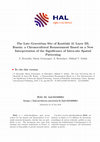
Journal of Paleolithic Archaeology, Mar 30, 2019
The site of Kostënki 21 (also known as Gmelin or Gmelinskaia) is located on the very edge of the ... more The site of Kostënki 21 (also known as Gmelin or Gmelinskaia) is located on the very edge of the Don River at Kostënki (Voronezh Oblast, Russia). The main archaeological horizon, layer III, is dated to c. 23,000-21,000 14 C BP (c. 27,500-24,500 cal BP) and contained six concentrations of archaeological material, mostly interpreted as the remains of dwelling structures. A substantial Gravettian lithic assemblage was found. The site has traditionally been seen as without parallels within the Gravettian chronocultural framework of Eastern Europe. It has long been noted that clear differences in the lithic typology and faunal assemblages of the six concentrations can be used to separate them into two groups, but this has previously been attributed to differences in the activities carried out in the two areas. In this paper, we argue that the two parts of the site were created at different times and that one part of the site can potentially be grouped with several other sites in Russia and Ukraine on lithic technotypological grounds. The degree of patination of the flint artefacts found at the site provides support for our interpretation.
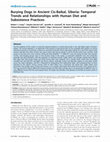
PLOS ONE, May 17, 2013
The first objective of this study is to examine temporal patterns in ancient dog burials in the L... more The first objective of this study is to examine temporal patterns in ancient dog burials in the Lake Baikal region of Eastern Siberia. The second objective is to determine if the practice of dog burial here can be correlated with patterns in human subsistence practices, in particular a reliance on terrestrial mammals. Direct radiocarbon dating of a suite of the region's dog remains indicates that these animals were given burial only during periods in which human burials were common. Dog burials of any kind were most common during the Early Neolithic (,7-8000 B.P.), and rare during all other time periods. Further, only foraging groups seem to have buried canids in this region, as pastoralist habitation sites and cemeteries generally lack dog interments, with the exception of sacrificed animals. Stable carbon and nitrogen isotope data indicate that dogs were only buried where and when human diets were relatively rich in aquatic foods, which here most likely included river and lake fish and Baikal seal (Phoca sibirica). Generally, human and dog diets appear to have been similar across the study subregions, and this is important for interpreting their radiocarbon dates, and comparing them to those obtained on the region's human remains, both of which likely carry a freshwater old carbon bias. Slight offsets were observed in the isotope values of dogs and humans in our samples, particularly where both have diets rich in aquatic fauna. This may result from dietary differences between people and their dogs, perhaps due to consuming fish of different sizes, or even different tissues from the same aquatic fauna. This paper also provides a first glimpse of the DNA of ancient canids in Northeast Asia.
Journal of Archaeological Science, 2012
Whether or not the wolf was domesticated during the early Upper Palaeolithic remains a controvers... more Whether or not the wolf was domesticated during the early Upper Palaeolithic remains a controversial issue. We carried out detailed analyses of the skull material from the Gravettian P redmostí site, Czech Republic, to investigate the issue. Three complete skulls from P redmostí were identified as Palaeolithic dogs, characterized by short skull lengths, short snouts, and wide palates and braincases relative to wolves. One complete skull could be assigned to the group of Pleistocene wolves. Three other skulls could not be assigned to a reference group; these might be remains from hybrids or captive wolves. Modifications by humans of the skull and canine remains from the large canids of P redmostí indicate a specific relationship between humans and large canids.
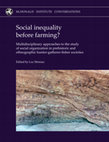
HAL (Le Centre pour la Communication Scientifique Directe), 2020
Nearest neighbour travel time against population density. 2.1. BaYaka playgroups tend to consist ... more Nearest neighbour travel time against population density. 2.1. BaYaka playgroups tend to consist of a broad range of ages and genders. 2.2. Flowchart of potential relationships in egalitarian or non-egalitarian social structures. 2.3. Flowchart of potential relationships in egalitarian or non-egalitarian social structures. 3.1. Illustrative example of the possible effect of mixed-sibling co-residence on the relatedness of groups. 3.2. Number of camps in which the average household is permitted to live. 5.1. Composition and kinship relationships of five hunting crews in Wales. 6.1. A Hadza man whittling a bow. 6.2. A map of the distribution of hand spears and spearthrowers throughout Australia. 6.3. A map of the recent historic distribution of blowdart use throughout the Old World. 6.4. A map of the recent historic distribution of blowdart use throughout the Americas. 7.1. Delayed return as a composite category. 8.1. A sketch of an Elk secret society dancer among the Ogalala Sioux on the American Plains. 8.2. Bone flutes used to represent the voices of spirits in Californian secret society rituals. 8.3. The interior of an Egbo ritual house of the Ekoi tribe in Nigeria. 8.4. The interior of an Egbo ritual house at Akangba, Nigeria. 8.5. The 'Sorcerer' from Les Trois Frères Cave in France. 8.6. Small dolmen containing the skull of a high-ranking member of a secret society on Vanuatu. 8.7. One of the skull cups recovered from the Solutrean deposits in Le Placard. 9.1. Net Primary Productivity and Effective Temperature conditions for extant fisher-hunter-gatherers. 138-9 9.2. Spatio-temporal distributions of NPP and ET in Upper Palaeolithic Europe. 140-1 9.3. Number of days per year with (growing) temperatures above 0°C, 5°C and 10°C. 142-3 9.4. Reconstructed population densities. 9.5.
The 81st Annual Meeting of the Society for American Archaeology, 2017
This article appeared in a journal published by Elsevier. The attached copy is furnished to the a... more This article appeared in a journal published by Elsevier. The attached copy is furnished to the author for internal non-commercial research and education use, including for instruction at the authors institution and sharing with colleagues. Other uses, including reproduction and distribution, or selling or licensing copies, or posting to personal, institutional or third party websites are prohibited. In most cases authors are permitted to post their version of the article (e.g. in Word or Tex form) to their personal website or institutional repository. Authors requiring further information regarding Elsevier's archiving and manuscript policies are encouraged to visit: http://www.elsevier.com/copyright
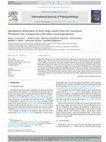
International Journal of Paleopathology, Dec 1, 2016
Spondylosis deformans is a common degenerative condition of the spinal column, especially in mode... more Spondylosis deformans is a common degenerative condition of the spinal column, especially in modern domestic dogs. The presence and severity of lesions are related to age and physical activity, but they can be influenced by genetics, with some modern breeds being particularly predisposed. Spondylosis deformans also has been reported in prehistoric dogs. Here, we describe three affected vertebrae, likely from three individuals, in a large canid assemblage from the Gravettian Předmostí site, Czech Republic. We compare the proportion of affected individuals from the Předmostí assemblage with that of affected individuals among recent wild Northern wolves, inbred wolves, captive wolves, and recent Northern dogs. The proportion of affected individuals among the captive wolves differs significantly from the other wolf groups. The proportion in the Předmostí assemblage does not differ significantly from that of the wild wolf groups.

Current Biology, Feb 1, 2022
Domestic dogs (Canis lupus familiaris) are the most variable-sized mammalian species on Earth, di... more Domestic dogs (Canis lupus familiaris) are the most variable-sized mammalian species on Earth, displaying a 40-fold size difference between breeds.1 Although dogs of variable size are found in the archeological record,2-4 the most dramatic shifts in body size are the result of selection over the last two centuries, as dog breeders selected and propagated phenotypic extremes within closed breeding populations.5 Analyses of over 200 domestic breeds have identified approximately 20 body size genes regulating insulin processing, fatty acid metabolism, TGFβ signaling, and skeletal formation.6-10 Of these, insulin-like growth factor 1 (IGF1) predominates, controlling approximately 15% of body size variation between breeds.8 The identification of a functional mutation associated with IGF1 has thus far proven elusive.6,10,11 Here, to identify and elucidate the role of an ancestral IGF1 allele in the propagation of modern canids, we analyzed 1,431 genome sequences from 13 species, including both ancient and modern canids, thus allowing us to define the evolutionary history of both ancestral and derived alleles at this locus. We identified a single variant in an antisense long non-coding RNA (IGF1-AS) that interacts with the IGF1 gene, creating a duplex. While the derived mutation predominates in both modern gray wolves and large domestic breeds, the ancestral allele, which predisposes to small size, was common in small-sized breeds and smaller wild canids. Our analyses demonstrate that this major regulator of canid body size nearly vanished in Pleistocene wolves, before its recent resurgence resulting from human-imposed selection for small-sized breed dogs.
Comptes Rendus Palevol, Nov 1, 2014
Human palaeontology and prehistory Early Humans at the eastern gate of Europe: The discovery and ... more Human palaeontology and prehistory Early Humans at the eastern gate of Europe: The discovery and investigation of Oldowan sites in northern Caucasus Premiers hommes de la porte orientale de l'Europe. Recherches et découvertes sur les sites d'Oldowan, Nord du Caucase
Journal of Archaeological Science, Feb 1, 2015
This is a reply to the comments of Morey (2014) on our identification of Palaeolithic dogs from s... more This is a reply to the comments of Morey (2014) on our identification of Palaeolithic dogs from several European Palaeolithic sites. In his comments Morey (2014) presents some misrepresentations and misunderstandings that we remedy here. In contrast to what Morey (2014) propounds, our results suggest that the domestication of the wolf was a long process that started early in the Upper Palaeolithic and that since that time two sympatric canid morphotypes can be seen in Eurasian sites: Pleistocene wolves and Palaeolithic dogs. Contrary to Morey (2014), we are convinced that the study of this domestication process should be multidisciplinary.
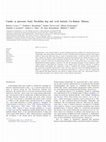
Journal of Anthropological Archaeology, Jun 1, 2011
Interpretations of dog burials made by ancient foraging groups have tended to be based upon our o... more Interpretations of dog burials made by ancient foraging groups have tended to be based upon our own relationships with such animals and modern western cosmological and ontological concepts. Osteological studies of early dogs often focus only on issues of taxonomy, and as a result very little is known about these animals' life histories. Eastern Siberia has produced many Holocene dog burials, but these are typically not well described and the explanatory frameworks provided for them are very underdeveloped. Here we examine in detail two Cis-Baikal canid burials, one of a wolf and the other a dog, both in large Middle Holocene hunter-gatherer cemeteries. We link the mortuary treatment of these animals to other cultural practices, particularly the treatment of the human dead, and broader patterns in Northern human-animal relationships. This interpretive model is combined with detailed osteobiographies for the canids and contextual information for these and other dogs and wolves from Middle Holocene Cis-Baikal. It is argued that canids here were understood and treated in a variety of ways. We suggest that some animals with unique histories were known as distinct persons with 'souls' and because of this at death required mortuary rites similar to those of their human counterparts. .
Proceedings of the National Academy of Sciences of the United States of America, Apr 17, 2007
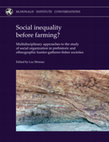
Nearest neighbour travel time against population density. 2.1. BaYaka playgroups tend to consist ... more Nearest neighbour travel time against population density. 2.1. BaYaka playgroups tend to consist of a broad range of ages and genders. 2.2. Flowchart of potential relationships in egalitarian or non-egalitarian social structures. 2.3. Flowchart of potential relationships in egalitarian or non-egalitarian social structures. 3.1. Illustrative example of the possible effect of mixed-sibling co-residence on the relatedness of groups. 3.2. Number of camps in which the average household is permitted to live. 5.1. Composition and kinship relationships of five hunting crews in Wales. 6.1. A Hadza man whittling a bow. 6.2. A map of the distribution of hand spears and spearthrowers throughout Australia. 6.3. A map of the recent historic distribution of blowdart use throughout the Old World. 6.4. A map of the recent historic distribution of blowdart use throughout the Americas. 7.1. Delayed return as a composite category. 8.1. A sketch of an Elk secret society dancer among the Ogalala Sioux on the American Plains. 8.2. Bone flutes used to represent the voices of spirits in Californian secret society rituals. 8.3. The interior of an Egbo ritual house of the Ekoi tribe in Nigeria. 8.4. The interior of an Egbo ritual house at Akangba, Nigeria. 8.5. The 'Sorcerer' from Les Trois Frères Cave in France. 8.6. Small dolmen containing the skull of a high-ranking member of a secret society on Vanuatu. 8.7. One of the skull cups recovered from the Solutrean deposits in Le Placard. 9.1. Net Primary Productivity and Effective Temperature conditions for extant fisher-hunter-gatherers. 138-9 9.2. Spatio-temporal distributions of NPP and ET in Upper Palaeolithic Europe. 140-1 9.3. Number of days per year with (growing) temperatures above 0°C, 5°C and 10°C. 142-3 9.4. Reconstructed population densities. 9.5.
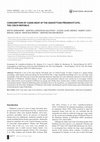
Fossil Imprint, 2017
Předmostí is one of the most famous Gravettian sites in Central Europe. Its fame is based on a un... more Předmostí is one of the most famous Gravettian sites in Central Europe. Its fame is based on a unique human assemblage, sadly largely destroyed during the Second World War, a huge mammoth assemblage and a very rich large canid assemblage. It has been shown previously that mammoth played an important role in the subsistence practices of the Gravettian inhabitants of Předmostí. Detailed analyses of the large canid postcranial material were carried out to investigate whether these canid remains can be assigned to different size groups and whether these remains show evidence of being butchered and consumed by humans. Based on defleshing marks and impact traces on the long bones, it is proposed here that large canids were consumed by the Gravettian inhabitants of Předmostí, thus further elucidating the specific human-large canid relationships that existed during the Upper Palaeolithic.

Quaternary Research, 2018
Higher δ15N values in bone collagen of mammoth (Mammuthus primigenius) compared with coeval large... more Higher δ15N values in bone collagen of mammoth (Mammuthus primigenius) compared with coeval large herbivores is a classic trait of the mammoth steppe. An exception applies to the Epigravettian site of Mezhyrich (ca. 18–17.4 ka cal BP) in the central East European plains, where mammoth bones have δ15N values equivalent to or in a lower range than those of horse specimens (Equussp.). We expanded our preliminary dataset to a larger sampling size of mammoth, other large herbivores, and carnivores from contemporaneous and nearby sites of Buzhanka 2, Eliseevichi, and Yudinovo. The unusual low mammoth δ15N values were confirmed at Buzhanka 2 and for some specimens from Eliseevichi, while most individuals from Yudinovo displayed the expected high δ15N values, meaning similar to those of the large canids. The possibility of a contrast in migration pattern is not supported since the δ34S values, a marker of mobility, do not correlate with the δ15N values of mammoth bone collagen. No clear chr...









Uploads
Papers by Mikhail V Sablin